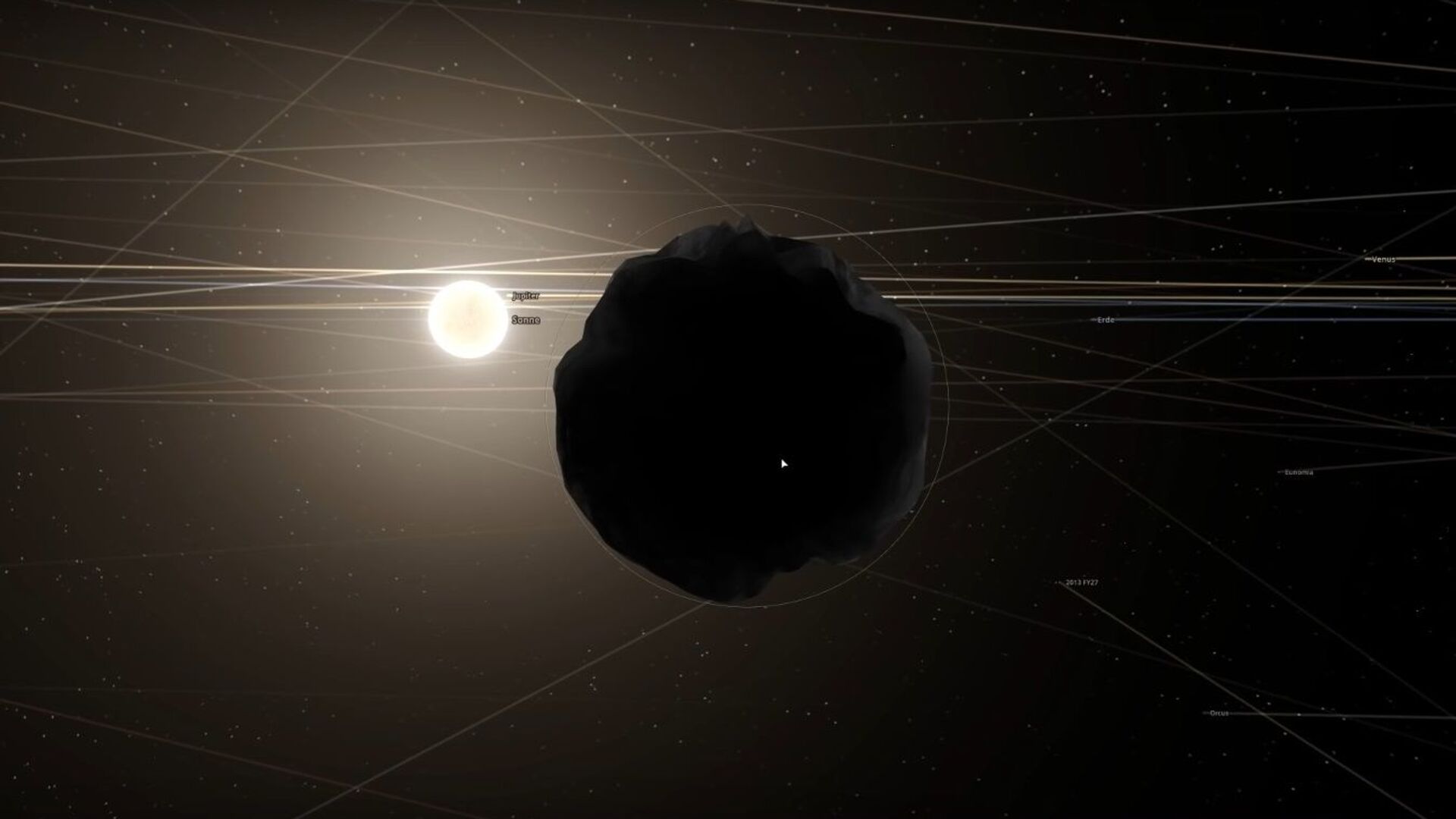https://sputnikglobe.com/20210825/scientists-discover-fastest-asteroid-with-shortest-known-orbit-ever-seen-in-solar-system-1083709980.html
Scientists Discover Fastest Asteroid With Shortest Known Orbit Ever Seen in Solar System
Scientists Discover Fastest Asteroid With Shortest Known Orbit Ever Seen in Solar System
Sputnik International
However, within just a few million years, it is possible that the asteroid will either be thrown out of its present trajectory, or be destroyed in a collision... 25.08.2021, Sputnik International
2021-08-25T17:42+0000
2021-08-25T17:42+0000
2022-11-03T19:34+0000
newsfeed
world
asteroids
asteroid belt
solar system
milky way
https://cdn1.img.sputnikglobe.com/img/07e5/08/19/1083711865_0:3:1351:763_1920x0_80_0_0_a707172868e0030ee3a36b78d63a16ce.jpg
Scientists have discovered the fastest asteroid that takes only 113 days to make one orbit of the sun. Named 2021 PH27, it was spotted by Dr Scott Sheppard of the Carnegie Institution for Science. The asteroid has the shortest orbital period of any celestial object in the solar system after Mercury, which takes only about 88 days to complete one revolution of the Sun.Generally, asteroids that are that close to the Sun are not easily traceable as they are often blocked by the Sun's glare. Using the Dark Energy Camera (DECam) on top of the Víctor M Blanco Telescope, Dr Sheppard spotted the rock on 13 August at Cerro Tololo Inter-American Observatory (CTIO) in Chile.Interestingly, the asteroid is estimated to be half as far from the Sun as Mercury is at its nearest approach. At its closest point, Mercury is 47 million kilometres from the sun whereas at its nearest point, 2021 PH27 zooms past the Sun at a distance of only 20 million kilometres during which its surface temperature rises to 500 degrees Celsius.He also said that 2021 PH27 may have dislodged from the main Asteroid Belt between Jupiter and Mars and the inner planets' gravity pulled it into its present configuration.After the discovery, the asteroid was photographed by scientists from Brown University during the twilight hours.Later, several other telescopes also conducted observations of the asteroid. Scientists are now planning to study and analyse the asteroid further. There is a possibility that 2021 PH27 will enter solar conjunction and it will be visible again.The scientists reported the discovery of 2021 PH27 in the Minor Planet Electronic Circular on 21 August.
solar system
milky way
Sputnik International
feedback@sputniknews.com
+74956456601
MIA „Rosiya Segodnya“
2021
Sushmita Panda
https://cdn1.img.sputnikglobe.com/img/07e5/05/12/1082926186_0:0:2048:2048_100x100_80_0_0_4474d0d7e27a36878eb8727832be74b4.jpg
Sushmita Panda
https://cdn1.img.sputnikglobe.com/img/07e5/05/12/1082926186_0:0:2048:2048_100x100_80_0_0_4474d0d7e27a36878eb8727832be74b4.jpg
News
en_EN
Sputnik International
feedback@sputniknews.com
+74956456601
MIA „Rosiya Segodnya“
Sputnik International
feedback@sputniknews.com
+74956456601
MIA „Rosiya Segodnya“
Sushmita Panda
https://cdn1.img.sputnikglobe.com/img/07e5/05/12/1082926186_0:0:2048:2048_100x100_80_0_0_4474d0d7e27a36878eb8727832be74b4.jpg
newsfeed, asteroids, asteroid belt, solar system, milky way
newsfeed, asteroids, asteroid belt, solar system, milky way
Scientists Discover Fastest Asteroid With Shortest Known Orbit Ever Seen in Solar System
17:42 GMT 25.08.2021 (Updated: 19:34 GMT 03.11.2022) However, within just a few million years, it is possible that the asteroid will either be thrown out of its present trajectory, or be destroyed in a collision with one of two planets - Venus or Mercury - or the Sun.
Scientists have
discovered the fastest asteroid that takes only 113 days to make one orbit of the sun. Named 2021 PH27, it was spotted by Dr Scott Sheppard of the Carnegie Institution for Science.
The asteroid has the shortest orbital period of any celestial object in the solar system after Mercury, which takes only about 88 days to complete one revolution of the Sun.
Generally, asteroids that are that close to the Sun are not easily traceable as they are often blocked by the Sun's glare. Using the Dark Energy Camera (DECam) on top of the Víctor M Blanco Telescope, Dr Sheppard spotted the rock on 13 August at Cerro Tololo Inter-American Observatory (CTIO) in Chile.
Interestingly, the asteroid is estimated to be half as far from the Sun as Mercury is at its nearest approach. At its closest point, Mercury is 47 million kilometres from the sun whereas at its nearest point, 2021 PH27 zooms past the Sun at a distance of only 20 million kilometres during which its surface temperature rises to 500 degrees Celsius.
"Understanding the population of asteroids inside Earth's orbit is important to complete the census of asteroids near Earth, including some of the most likely impactors that may approach Earth during daylight and that cannot easily be discovered in most surveys that are observing at night, away from the Sun," Dr. Sheppard said.
He also said that 2021 PH27 may have dislodged from the main
Asteroid Belt between Jupiter and Mars and the inner planets' gravity pulled it into its present configuration.
After the discovery, the asteroid was photographed by scientists from Brown University during the twilight hours.
Later, several other telescopes also conducted observations of the asteroid. Scientists are now planning to study and analyse the asteroid further. There is a possibility that 2021 PH27 will enter solar conjunction and it will be visible again.
The scientists reported the discovery of 2021 PH27 in the
Minor Planet Electronic Circular on 21 August.





